Analysis of the Impact of Information Behavior on the Marketing and Fertilization Strategies of Small Cocoa Producers in the Provinces of Guayas and Los Ríos in Ecuador
Abstract
1. Introduction
- -
- To what extent does information behavior, structured along five dimensions (information sources, information evaluation, informational, social and economic), influence the effectiveness of marketing strategies of smallholder cocoa farmers?
- -
- How do current fertilization practices align with efficient practices in soil fertilization processes for cocoa cultivation?
- -
- Is there a relationship between access to technical agricultural information and competitiveness indexes in the production and commercial processes of small cocoa producers?
2. Review and Theoretical Perspectives of the Cocoa Sector in Ecuador
2.1. Historical References of the Cocoa Value Chain
2.2. Fertilization of Cocoa Areas
2.3. Information Management for Agricultural Decision-Making
2.4. Digital Traceability in Agricultural Production
2.5. Digitalization as a Driver for Sustainable Strategies and Green Marketing
2.5.1. The Role of Digital Marketing in Attracting Agricultural Investment
2.5.2. Balancing Business Sustainability and Natural Resources in the Digital Era
2.5.3. E-Commerce as a Platform for Green Marketing and Negotiation Strategies
2.5.4. Sustainable Business Transitions and the Rise of Green Businesses
2.6. Research Gap and Operational Framework for Information Behavior
- Information sources: ability to identify and locate available data sources.
- Information evaluation: ability to judge the quality, relevance and usefulness of information, applying established criteria and standards.
- Informative: ability to retrieve data for the purpose of repeated use.
- Social: ability to interact with other individuals and share information.
- Economic: ability to employ information as a means to improve related skills in job performance.
3. Research Methodology
3.1. Description of the Study Area
3.2. Sampling and Data Collection Methodology
3.2.1. Producer Selection
3.2.2. Selection of Soil Samples
Soil Nutrient Diagnosis
pH Concentration
Organic Matter (OM) Concentration
Total Nitrogen Concentration (N)
Concentration of Calcium (Ca), Magnesium (Mg) and Exchangeable Potassium (K)
Available Phosphorus Concentration
Cadmium Concentration
Exchangeable Aluminum (AI) Concentration
Copper and Iron Concentration
3.3. Data Analysis
4. Results and Discussion
4.1. Profile of Smallholder Cocoa Farmers
4.2. The Influence of Information Competencies in the Marketing Field
4.3. Analysis of Soil Nutritional Quality in Small-Scale Cocoa Farms
5. Conclusions
5.1. Limitations of the Study
- Since data were collected from 50 plantations, generalization of the results could be limited because only two provinces were included (Guayas and Los Rios). This excludes other cocoa-growing regions of Ecuador that might have different agroclimatic conditions and agricultural practices.
- This study focused on the chemical characteristics of the soil and the informational capabilities of the farmers, leaving aside biological and physical aspects of the soil that can also influence cocoa yields.
- Although social and economic factors are analyzed, the complexity of these variables may require further research to fully understand their impact on productivity and marketing.
- The analysis was based on period-specific data, which limits the possibility of capturing seasonal variations or long-term changes in farming practices and soil conditions.
5.2. Recommendations for Future Studies
- Implement training programs aimed at cocoa producers, especially in the province of Los Ríos, to improve access to and use of digital platforms, technical publications and agricultural information networks.
- Promote producer associations and cooperatives that facilitate the exchange of information and successful experiences in the marketing and management of the crop.
- Promote the use of periodic soil analysis and technical advice to adjust fertilization practices according to the specific needs of the crop.
- Develop awareness and practical training strategies that facilitate the progressive adoption of new technologies in cocoa production. This includes access to technical advice in the field and the integration of accessible digital solutions for small producers.
Author Contributions
Funding
Institutional Review Board Statement
Informed Consent Statement
Data Availability Statement
Acknowledgments
Conflicts of Interest
References
- Valenzuela-Cobos, J.; Guevara-Viejó, F.; Galindo-Villardón, P.; Vicente-Galindo, P. Three-Dimensional Analysis of the Impact of Different Concentrations of Glyphosate on the Growth of Cocoa (Theobroma cacao). Appl. Sci. 2024, 14, 8180. [Google Scholar] [CrossRef]
- Muller, M.; Valle, R. Ecofisiologia Do Cultivo Do Cacaueiro. In Ciência, Tecnologia e Manejo do Cacaueiro; Gráfica Editora Vital Ltd.: Itabuna, BA, Brazil, 2007; Volume 1, pp. 17–41. [Google Scholar]
- Verna, R. The History and Science of Chocolate. Malays. J. Pathol. 2013, 35, 111–121. [Google Scholar]
- FAO. La Cadena de Valor Del Cacao En El Ecuador: Diagnóstico Actual; FAO: Rome, Italy, 2010. [Google Scholar]
- Carr, M.K.V.; Lockwood, G. The Water Relations and Irrigation Requirements of Cocoa (Theobroma cacao): A Review. Exp. Agric. 2011, 47, 653–676. [Google Scholar] [CrossRef]
- Márdero, S.; Nickl, E.; Schmook, B.; Schneider, L.; Rogan, J.; Christman, Z.; Lawrence, D. Sequías En El Sur de La Península de Yucatán: Análisis de La Variabilidad Anual y Estacional de La Precipitación. Investig. Geogr. 2012, 78, 19–33. [Google Scholar] [CrossRef]
- Medina, V.; Laliberte, B. Review of Research on the Effects of Drought and Temperature Stress and Increased CO2 on Theobroma cacao L., and the Role of Genetic Diversity to Address Climate Change; Bioversity International: Rome, Italy, 2017. [Google Scholar]
- Saravia-Matus, S.L.; Rodríguez, A.G.; Saravia, J.A. Determinants of Certified Organic Cocoa Production: Evidence from the Province of Guayas, Ecuador. Org. Agric. 2020, 10, 23–34. [Google Scholar] [CrossRef]
- Rezabala Encalada, Y.A.; Pilar, F.V. Comercialización de Productos Agrícolas En La Economía Popular y Solidaria de La Provincia de Manabí. Mikarimin Rev. Científica Multidiscip. 2024, 10, 101–121. [Google Scholar] [CrossRef]
- Sideridis, A.; Koukouli, M.; Antonopoulou, E. ICT and Farmers: Lessons Learned and Future Developments. J. Agric. Inform. 2011, 1, 1–7. [Google Scholar] [CrossRef]
- Rao, N.H. A Framework for Implementing Information and Communication Technologies in Agricultural Development in India. Technol. Forecast. Soc. Chang. 2007, 74, 491–518. [Google Scholar] [CrossRef]
- Ekbia, H.R.; Evans, T.P. Regimes of Information: Land Use, Management, and Policy. Inf. Soc. 2009, 25, 328–343. [Google Scholar] [CrossRef]
- Weller, J. Brechas y Transformaciones: La Evolución Del Empleo Agropecuario En América Latina; Naciones Unidas: New York, NY, USA, 2017. [Google Scholar]
- Conti, C.; Zanello, G.; Hall, A. Why Are Agri-Food Systems Resistant to New Directions of Change? A Systematic Review. Glob. Food Secur. 2021, 31, 100576. [Google Scholar] [CrossRef]
- INEC. Población y Demografía. 2022. Available online: https://www.ecuadorencifras.gob.ec/censo-de-poblacion-y-vivienda/ (accessed on 17 February 2025).
- Ministerio de Producción, Comercio Exterior, Inversiones y Pesca. Apoyo a Las MyPymes Ecuatorianas Para La Promoción y Exportación Sostenibles a La Unión Europea—Export—Des; Ministerio de Producción, Comercio Exterior, Inversiones y Pesca: Quito, Ecuador, 2020.
- Ministerio de Agricultura y Ganadería. Rendimientos de Cacao 2023—Caracterización Producción; Ministerio de Agricultura y Ganadería: Quito, Ecuador, 2023.
- INEC. Encuesta de Superficie y Producción Agropecuaria Continua; INEC: Quito, Ecuador, 2023. [Google Scholar]
- García, A.; Pico, B.; Jaimez, R. La cadena de producción del Cacao en Ecuador: Resiliencia en los diferentes actores de la producción. Novasinergia Rev. Digit. Cienc. Ing. Tecnol. 2021, 4, 152–172. [Google Scholar] [CrossRef]
- European Forest Institute. Diagnóstico de La Cadena de Valor Del Cacao, y Mapeo de Los Indicadores y Sistemas de Información Existentes; European Forest Institute: Joensuu, Finland, 2021. [Google Scholar]
- Sánchez, V.; Zambrano, J.; Inglesias, C. La Cadena de Valor Del Cacao En América Latina y El Caribe; INIAP (Instituto Nacional de Investigaciones Agropecuarias): Quito, Ecuador, 2019. [Google Scholar]
- Gutiérrez Cano, L.F.; Zartha Sossa, J.W.; Moreno Sarta, J.F.; Oviedo Lopera, J.C.; Quintero Saavedra, J.I.; Suárez Guzmán, L.M.; Agudelo Tapasco, D.A. National Agricultural Innovation System (NAIS): Diagnosis, Gaps, and Mapping of Actors. Sustainability 2024, 16, 3294. [Google Scholar] [CrossRef]
- Tovar-Quiroz, A.D. Agricultura 4.0: Uso de Tecnológicas de Precisión y Aplicación Para Pequeños Productores. Inf. Téc. 2023, 87, 168–184. [Google Scholar] [CrossRef]
- Rincón, N.; Segovia, E.; Aguilera, G.; López, A.; Zavarce, E.; Leal, M. Los Pequeños Productores y Su Participación En El Proceso de Comercialización Agrícola. Rev. Fac. Agron. 2004, 21, 172–185. [Google Scholar]
- Camacho, A.; Conover, E. The Impact of Receiving SMS Price and Weather Information on Small Scale Farmers in Colombia. World Dev. 2019, 123, 104596. [Google Scholar] [CrossRef]
- Mwombe, S.O.L.; Mugivane, F.I.; Adolwa, I.S.; Nderitu, J.H. Evaluation of Information and Communication Technology Utilization by Small Holder Banana Farmers in Gatanga District, Kenya. J. Agric. Educ. Ext. 2014, 20, 247–261. [Google Scholar] [CrossRef]
- Muñoz, M.; Mera, R.; Artieda, J.; Vega, V. Tecnologías de La Información y Comunicación En La Agricultura. Uniandes Episteme. Rev. Digit. Cienc. Tecnol. Innovación 2017, 4, 105–116. [Google Scholar]
- Schoneveld, G.C. Host Country Governance and the African Land Rush: 7 Reasons Why Large-Scale Farmland Investments Fail to Contribute to Sustainable Development. Geoforum 2017, 83, 119–132. [Google Scholar] [CrossRef]
- Janus, S.S. Becoming a Knowledge-Sharing Organization: A Handbook for Scaling Up Solutions through Knowledge Capturing and Sharing; World Bank Group: Washington, DC, USA, 2016; Available online: http://documents.worldbank.org/curated/en/972111468758711518 (accessed on 17 February 2025).
- ProColombia. Atracción de Inversión Para El Desarrollo Sostenible de Los Territorios de Colombia; ProColombia: Bogotá, Colombia, 2022. [Google Scholar]
- Madhur, G. Agricultural Extension. Kenyan Exp. 1999, 1, 23002. [Google Scholar]
- Alemu, Y.; Tolossa, D. Consultation and Displacement in Large-Scale Agriculture Investment: Evidence from Oromia Region’s Shashamane Rural District. Land 2022, 11, 1384. [Google Scholar] [CrossRef]
- Moreda, T. The Right to Food in the Context of Large-Scale Land Investment in Ethiopia. Third World Q. 2018, 39, 1326–1347. [Google Scholar] [CrossRef]
- Kumar, A.; Trivedi, A.; Nandeha, N.; Niveditha, M.P. Sustainable Agriculture Development and Optimum Utilization of Natural Resources: Striking a Balance. J. Sci. Res. Rep. 2024, 30, 477–486. [Google Scholar] [CrossRef]
- Marulanda-Grisales, N.; Herrera-Pulgarín, J.J.; Urrego-Marín, M.L. Knowledge Management Practices as an Opportunity for the Achievement of Sustainable Development in Social Enterprises of Medellín (Colombia). Sustainability 2024, 16, 1170. [Google Scholar] [CrossRef]
- Demianchuk, M.; Koval, V.; Hordopolov, V.; Kozlovtseva, V.; Atstaja, D. Ensuring Sustainable Development of Enterprises in the Conditions of Digital Transformations. E3S Web Conf. 2021, 280, 02002. [Google Scholar] [CrossRef]
- Stawicka, E. Sustainable Development in the Digital Age of Entrepreneurship. Sustainability 2021, 13, 4429. [Google Scholar] [CrossRef]
- Белчева, М. Achieving Sustainability in the Management of Natural Resources Given to a Concession. Econ. Soc. Altern. 2024, 30, 44–61. [Google Scholar] [CrossRef]
- Shamin, A.; Frolova, O.; Makarychev, V.; Yashkova, N.; Kornilova, L.; Akimov, A. Digital Transformation of Agricultural Industry. IOP Conf. Ser. Earth Environ. Sci. 2019, 346, 012029. [Google Scholar] [CrossRef]
- Zhang, C.; Tian, X.; Sun, X.; Xu, J.; Gao, Y. Digital Transformation, Board Diversity, and Corporate Sustainable Development. Sustainability 2024, 16, 7788. [Google Scholar] [CrossRef]
- Hrustek, L. Sustainability Driven by Agriculture through Digital Transformation. Sustainability 2020, 12, 8596. [Google Scholar] [CrossRef]
- Fu, W.; Choi, E.-K.; Kim, H.-S. Text Mining with Network Analysis of Online Reviews and Consumers’ Satisfaction: A Case Study in Busan Wine Bars. Information 2022, 13, 127. [Google Scholar] [CrossRef]
- Young, M.; Soza-Parra, J.; Circella, G. The Increase in Online Shopping during COVID-19: Who Is Responsible, Will It Last, and What Does It Mean for Cities? Reg. Sci. Policy Pract. 2022, 14, 162–179. [Google Scholar] [CrossRef]
- Shao, J.; Feng, Y.; Liu, Z. The Impact of Big Data-Driven Strategies on Sustainable Consumer Behaviour in E-Commerce: A Green Economy Perspective. Sustainability 2024, 16, 10960. [Google Scholar] [CrossRef]
- Afanasyev, K.; Hanechko, I.; Trubei, O.; Lukhanina, K. Approaches to Modelling Marketing Strategies in E-Commerce. Econ. Ecol. Socium 2024, 8, 67–77. [Google Scholar] [CrossRef]
- Rui, M.; Sparacino, A.; Merlino, V.M.; Brun, F.; Massaglia, S.; Blanc, S. Exploring Consumer Sentiments and Opinions in Wine E-Commerce: A Cross-Country Comparative Study. J. Retail. Consum. Serv. 2025, 82, 104097. [Google Scholar] [CrossRef]
- Liu, P.; Yi, S. Pricing Policies of Green Supply Chain Considering Targeted Advertising and Product Green Degree in the Big Data Environment. J. Clean. Prod. 2017, 164, 1614–1622. [Google Scholar] [CrossRef]
- Qi, B.; Deng, T.; Yang, Z. The Role of User Experience in the Impact of Low-Carbon Building Characteristics on Consumer’s Housing Purchase Intention. Sustainability 2023, 15, 10194. [Google Scholar] [CrossRef]
- Chien, S.H.; Wu, J.J.; Lai, H.F. Market Orientation and Strategies in E-Commerce Companies. In Proceedings of the 2008 6th IEEE International Conference on Industrial Informatics, Daejeon, Republic of Korea, 13–16 July 2008; pp. 1232–1237. [Google Scholar] [CrossRef]
- Shumska, S.; Stepanenko, B. Methodology Features of Green Business Development. Sustain. Dev. 2012, 3, 146–149. [Google Scholar]
- Hernández-Chea, R.; Jain, A.; Bocken, N.M.P.; Gurtoo, A. The Business Model in Sustainability Transitions: A Conceptualization. Sustainability 2021, 13, 5763. [Google Scholar] [CrossRef]
- Mahajan, N.; Kaur, N.; Singh, V.; Gupta, A.; Garg, N. Green Trade: Transition Towards a Sustainable Economy. IOP Conf. Ser. Earth Environ. Sci. 2023, 1279, 012023. [Google Scholar] [CrossRef]
- Wannags, L.L.; Gold, S. Assessing Tensions in Corporate Sustainability Transition: From a Review of the Literature towards an Actor-Oriented Management Approach. J. Clean. Prod. 2020, 264, 121662. [Google Scholar] [CrossRef]
- Kajanová, J.; Matúšová, S.; Nováček, P. Sustainable Business in the European Economic Area. Jurid. Trib. 2023, 12. [Google Scholar] [CrossRef]
- Lowder, S.; Skoet, J.; Raney, T. The Number, Size, and Distribution of Farms, Smallholder Farms, and Family Farms Worldwide. World Dev. 2015, 87, 16–29. [Google Scholar] [CrossRef]
- Damián Quito, L.F.; Angulo González, A.J.; Villavicencio Yanos, J.A.; Santander Villao, M.O. Caracterización Agro-Socioeconómica de Los Productores de Cacao (Theobroma cacao L.) En El Recinto El Rosario, Cantón Naranjito, Guayas. Pro Sci. Rev. Prod. Cienc. Investig. 2022, 6, 399–408. [Google Scholar] [CrossRef]
- Magesa, M.M.; Michael, K.; Ko, J. Access and Use of Agricultural Market Information by Smallholder Farmers: Measuring Informational Capabilities. Electron. J. Inf. Syst. Dev. Ctries. 2020, 86, e12134. [Google Scholar] [CrossRef]
- Moreno Rodríguez, J.M.; Gelvez Pardo, I.M.; Santos Díaz, A.M. Guía de Muestreo de Suelo Para Análisis Microbiológico, Primera; Corporación Colombiana de Investigación Agropecuaria (Agrosavia): Cundinamarca, Columbia, 2020. [Google Scholar] [CrossRef]
- Loli, O. Guía Técnica “Análisis de Suelos y Fertilización En El Cultivo de Cacao”; Nuevo Bambamarca: Tarapoto, Perú, 2012. [Google Scholar]
- Francisco-Santiago, S.P.; Palma-López, D.J.; Sánchez-Hernández, R.; Obrador-Olán, J.J.; García-Alamilla, P. Fertilidad Edáfica y Nutrición En El Cultivo de Cacao (Theobroma cacao L.) En Tres Suelos de Tabasco, México. Terra Latinoam. 2023, 41. [Google Scholar] [CrossRef]
- AOAC International. Official Methods of Analysis of the Association of Official; AOAC International: Rockville, MD, USA, 1990. [Google Scholar]
- Carrero, A.; Zambrano, A.; Hernández, E.; Contreras, F.; Machado, D.; Bianchi, G.; Varela, R. Comparación de Dos Métodos de Extracción de Fósforo Disponible En Un Suelo Ácido. Av. Quím. 2015, 10, 29–33. [Google Scholar]
- Carrillo, I.; Gómez, A. Métodos de Yuan y Espectrofotometría de Absorción Atómica (E.A.A.). Para Determ. Alum. Intercambiable Suelos Cafe. Colomb. 1976, 27, 1. [Google Scholar]
- Domingues, G.; Loureiro, V.; Afonso, E. Análise de Regressão Linear No Pacote R. Univ. Fed. Minas Gerais Belo Horiz. 2009. [Google Scholar]
- Nunnally, J.C.; Bernstein, I.H. Psychometric Theory, 3rd ed.; McGraw-Hill: New York, NY, USA, 1994. [Google Scholar]
- Gumbi, N.; Gumbi, L.; Twinomurinzi, H. Towards Sustainable Digital Agriculture for Smallholder Farmers: A Systematic Literature Review. Sustainability 2023, 15, 12530. [Google Scholar] [CrossRef]
- Zhu, X.; Wang, G. Impact of Agricultural Cooperatives on Farmers’ Collective Action: A Study Based on the Socio-Ecological System Framework. Agriculture 2024, 14, 96. [Google Scholar] [CrossRef]
- Zanello, G.; Srinivasan, C.S. Information Sources, ICTs and Price Information in Rural Agricultural Markets. Eur. J. Dev. Res. 2014, 26, 815–831. [Google Scholar] [CrossRef]
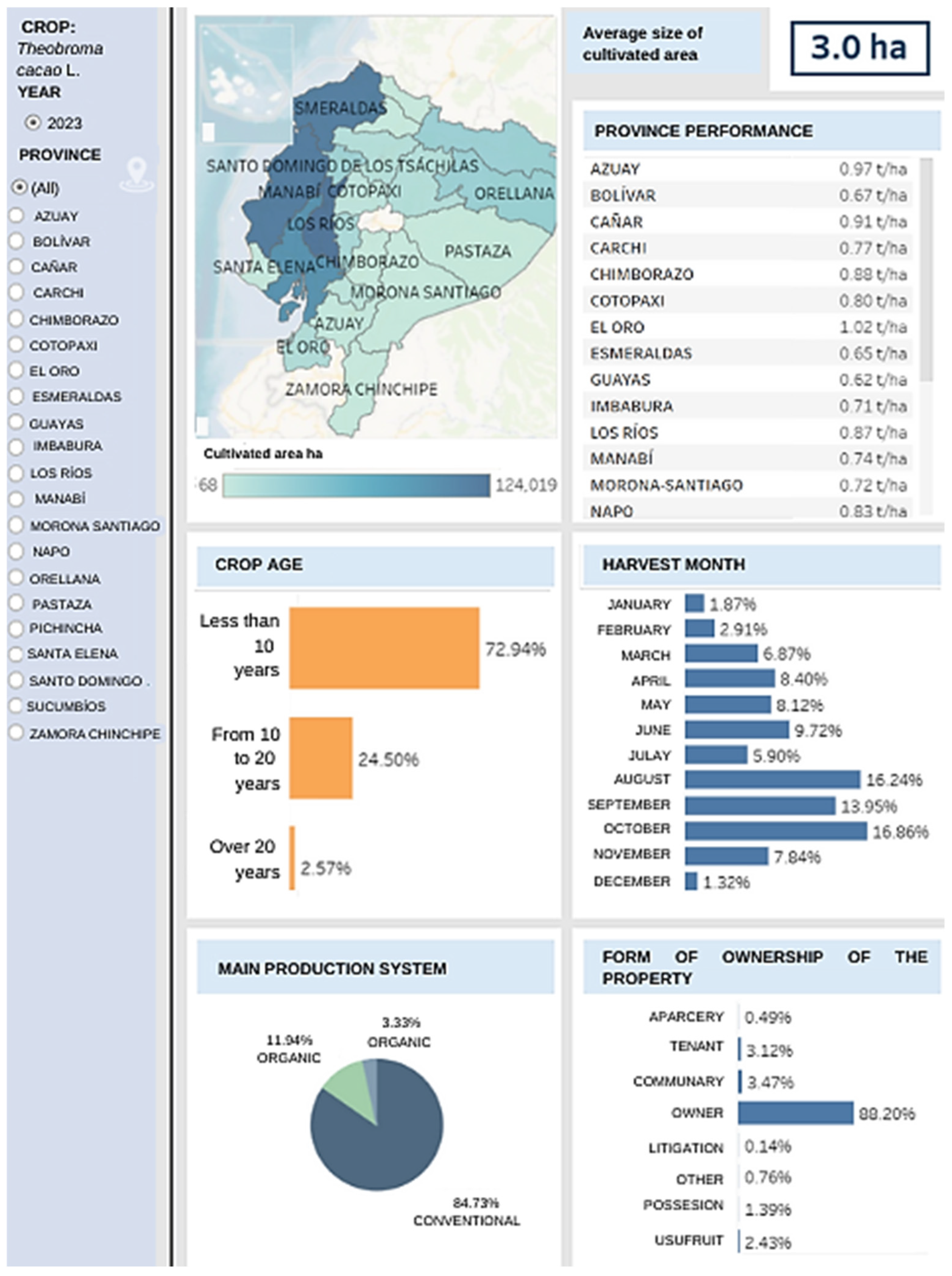

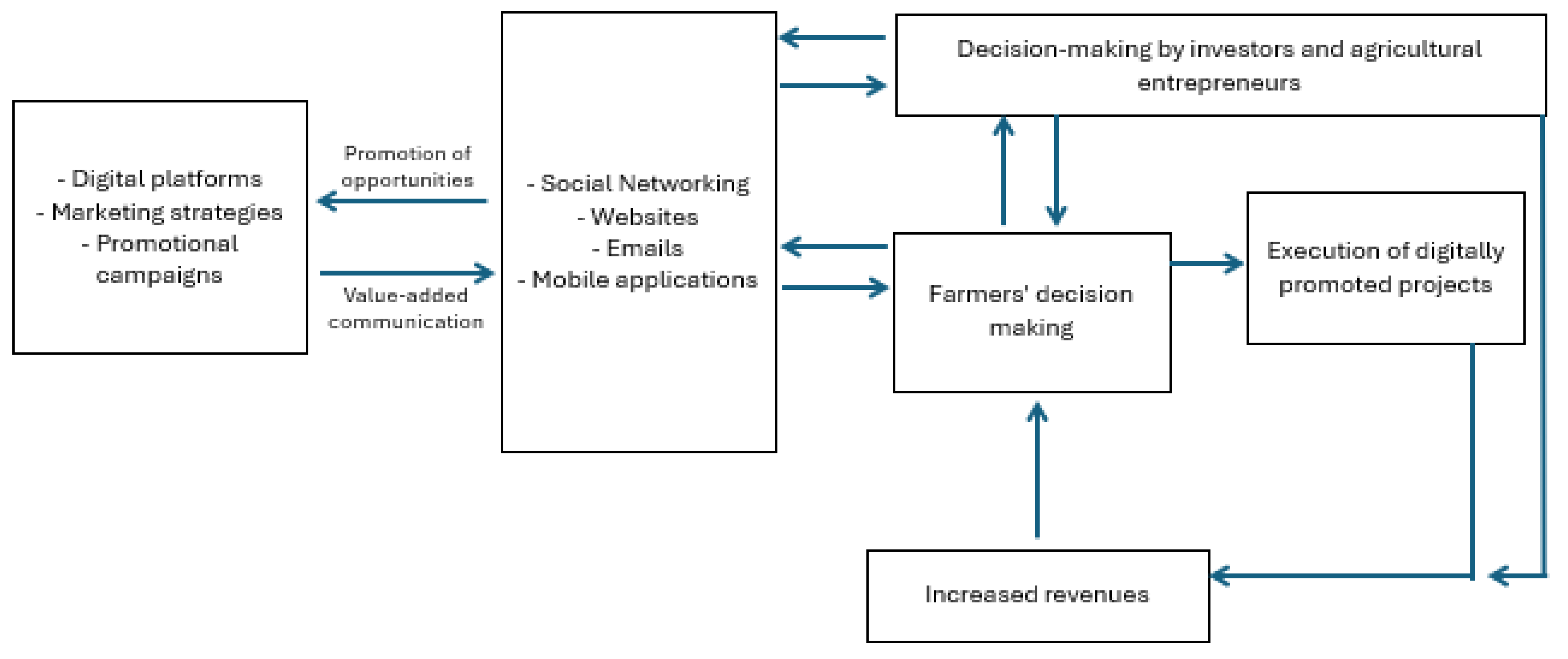
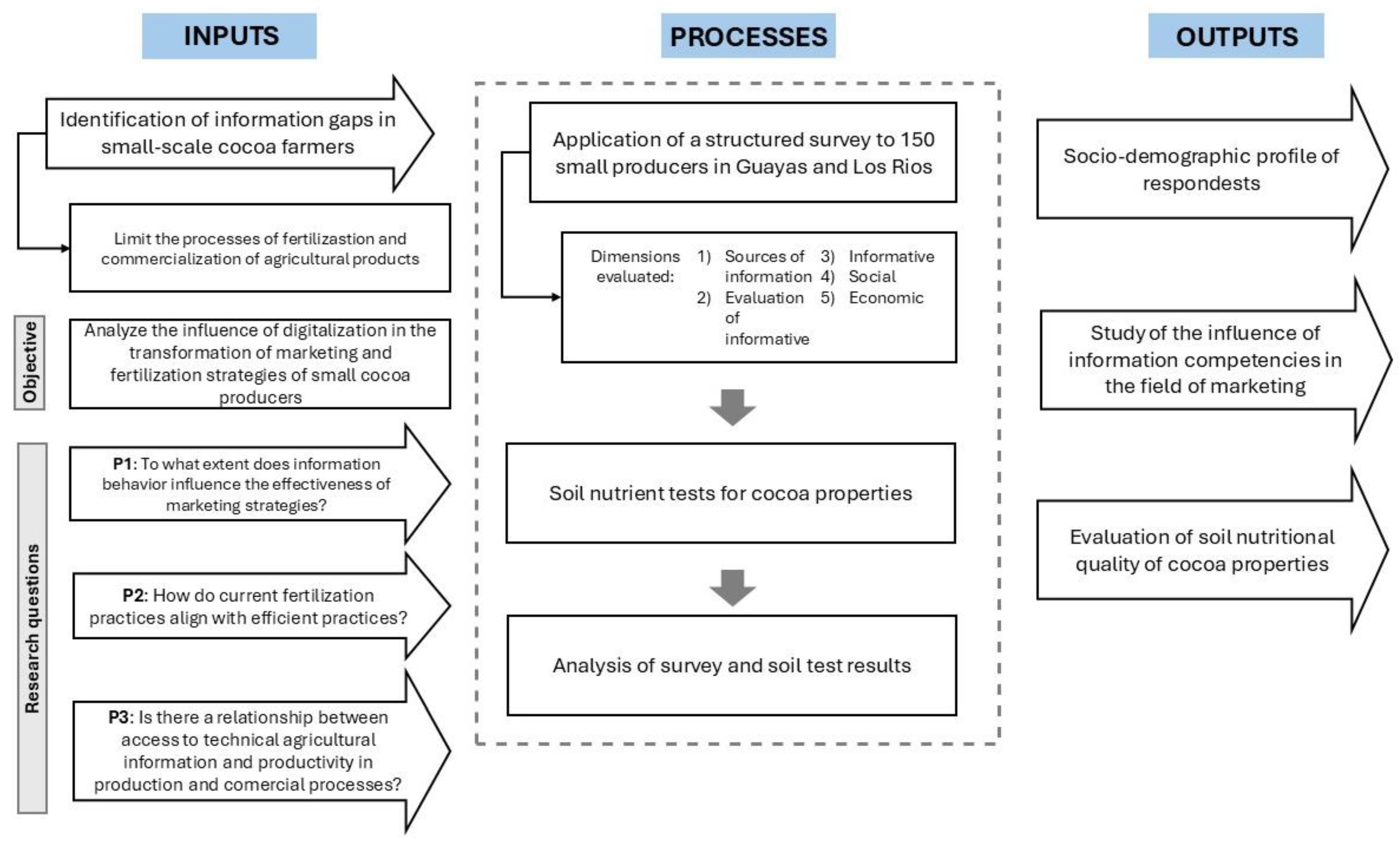
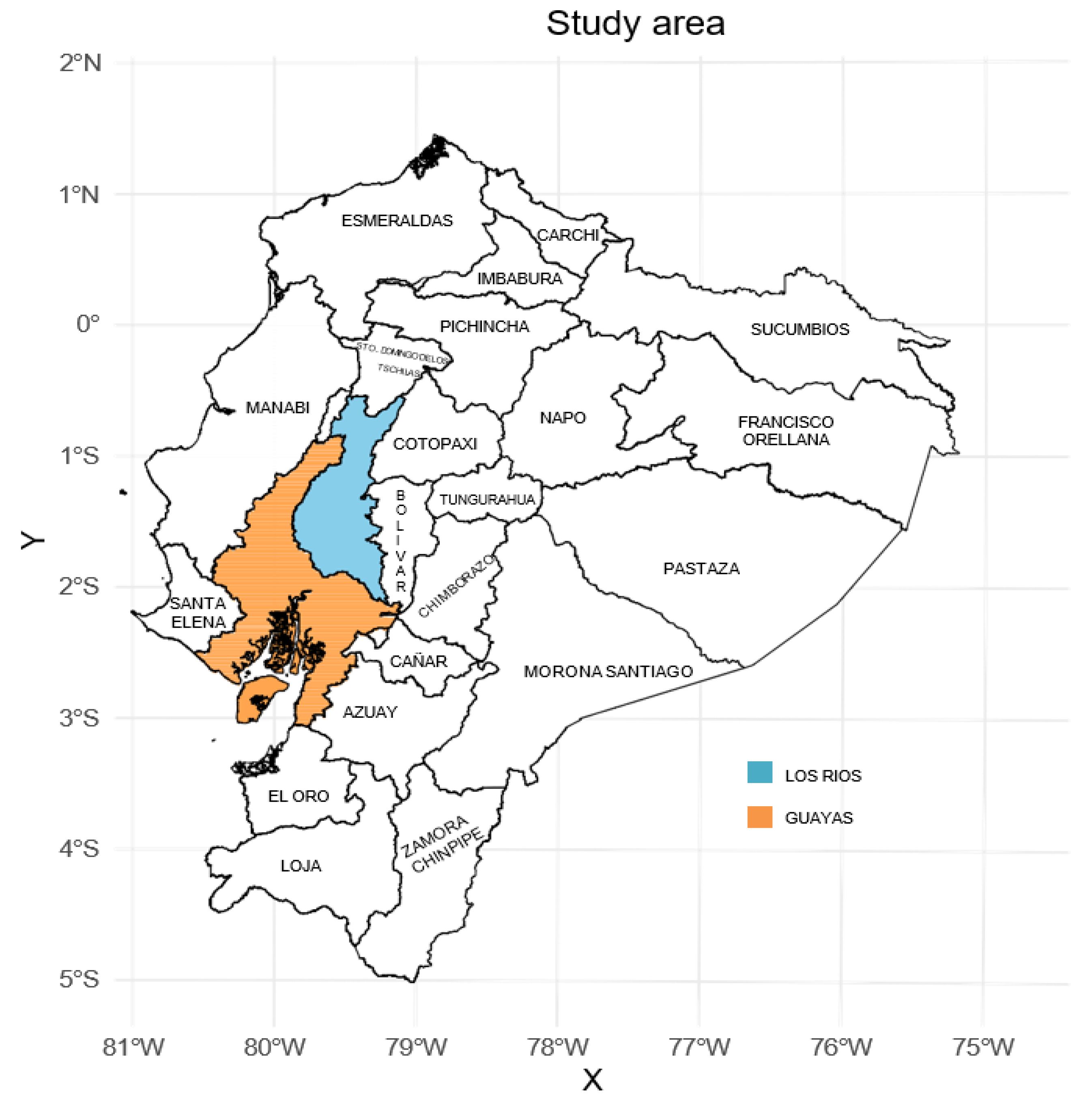
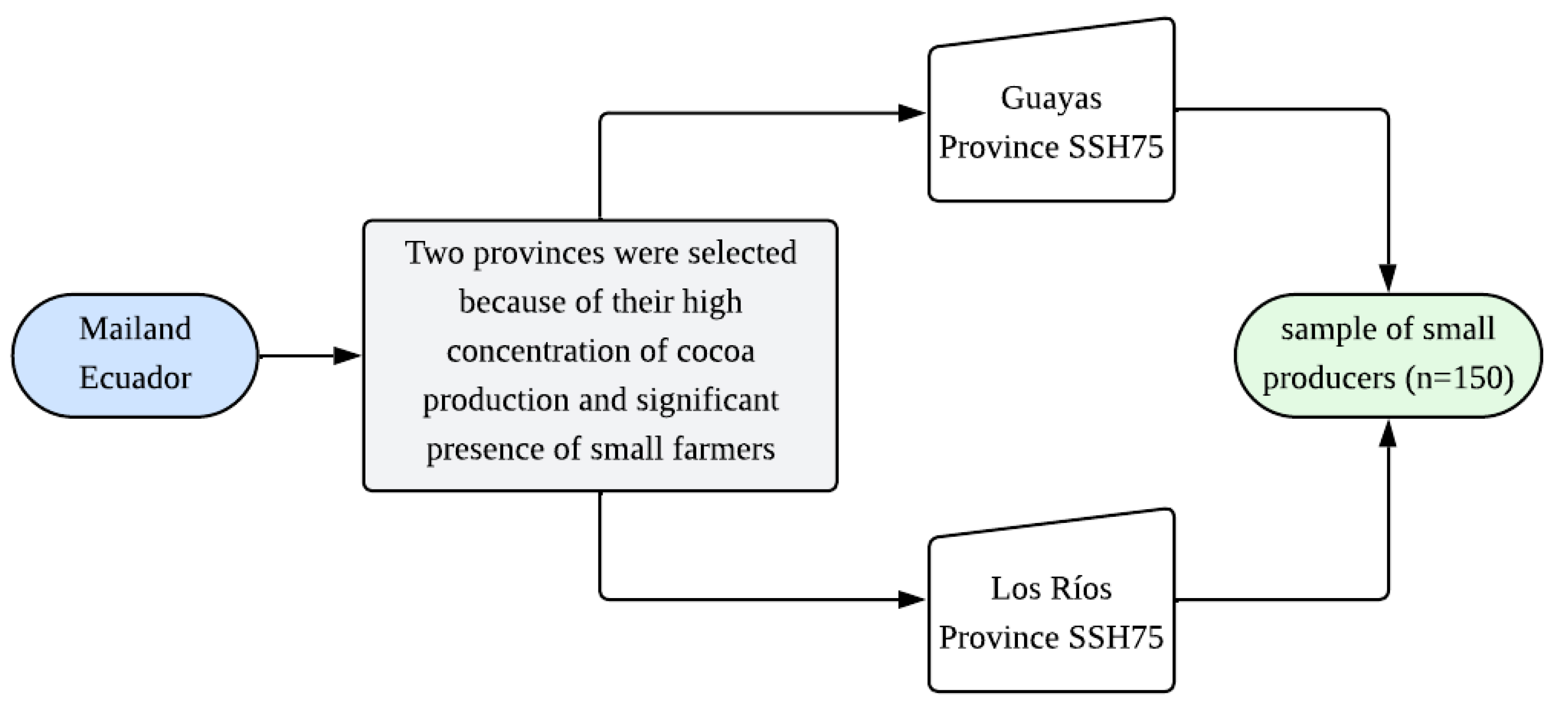
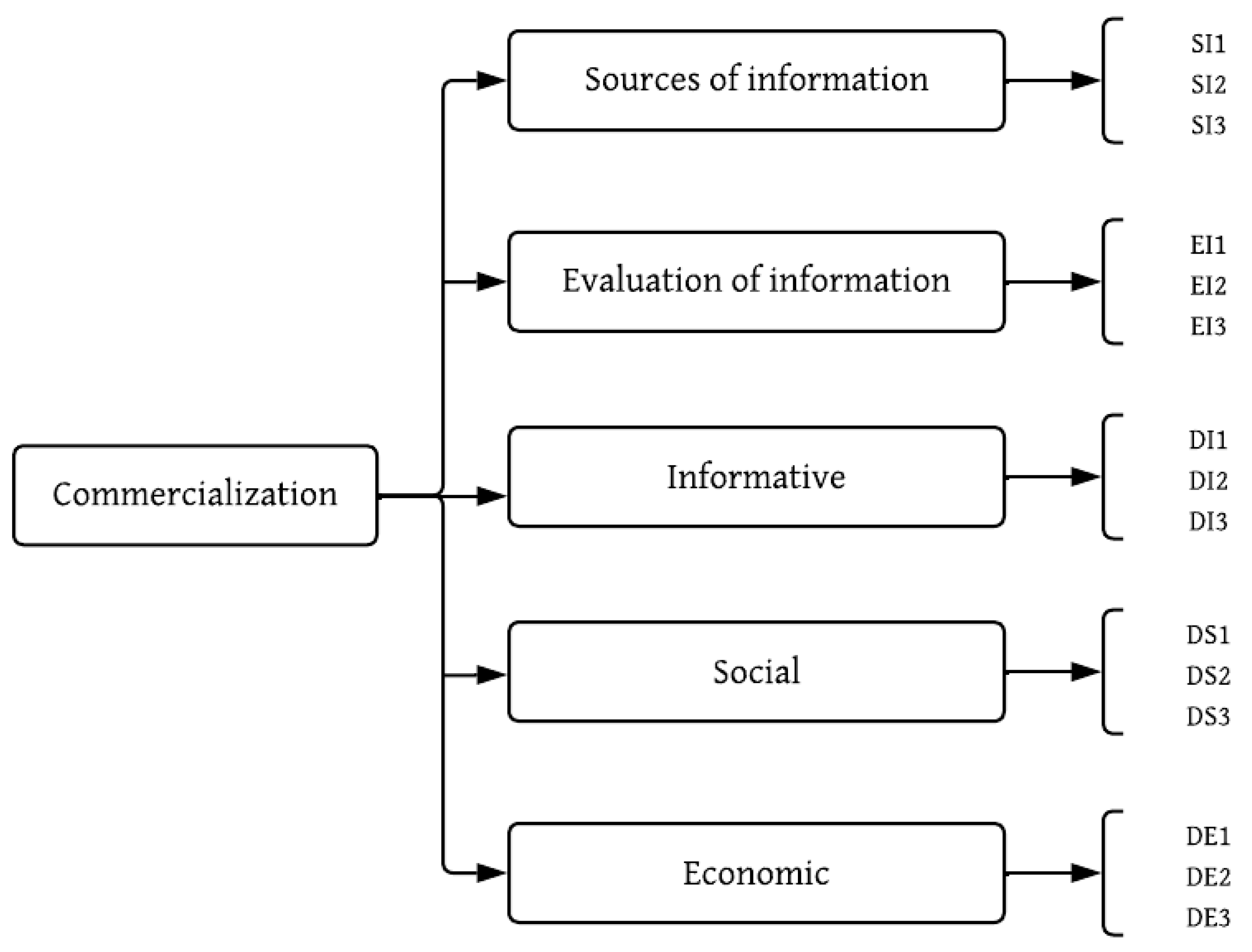
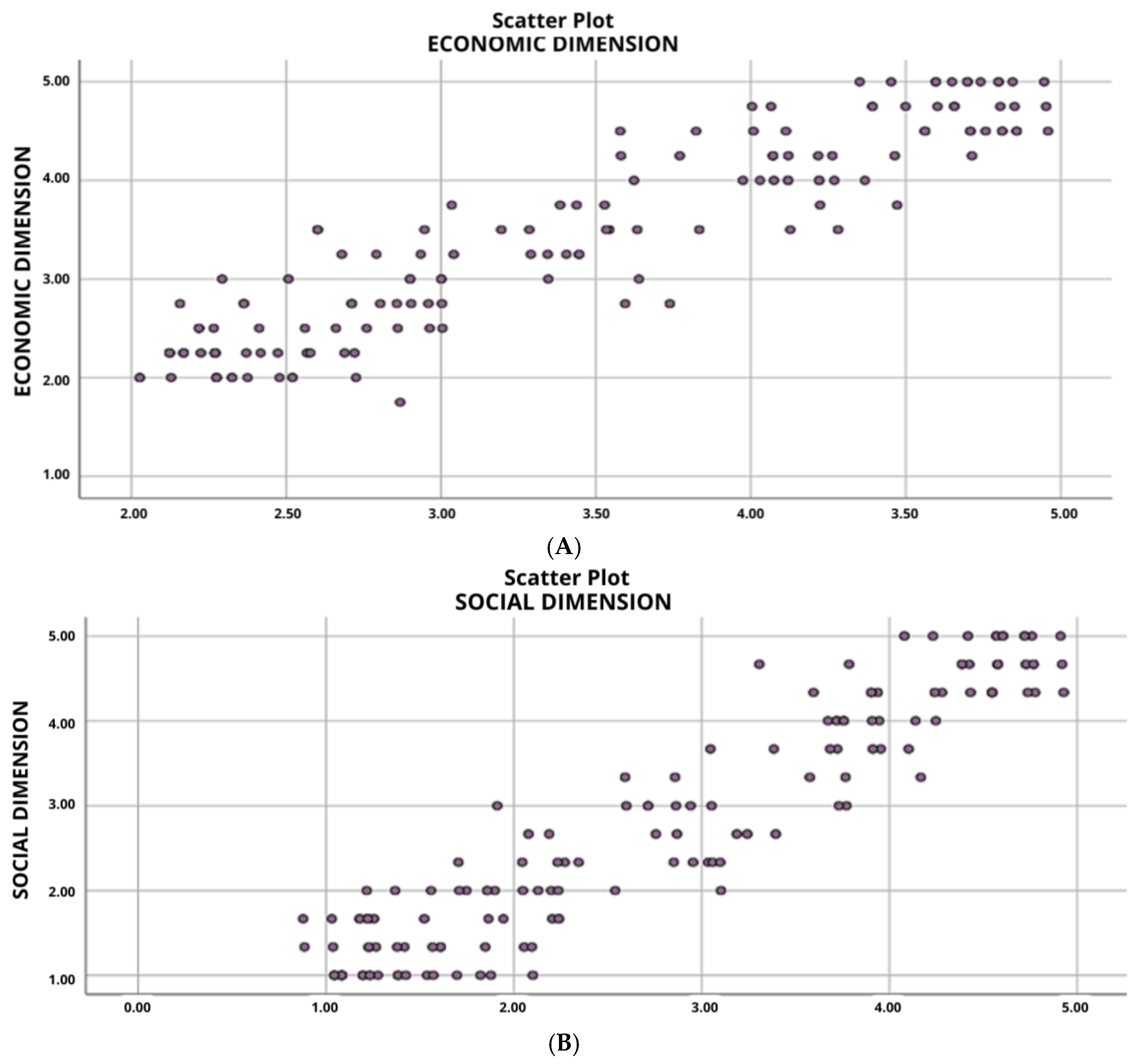
| Dimension | Indicator | Nomenclature | Description |
|---|---|---|---|
| Sources of information | Print publications | SI1 | Use of printed media as a source of agricultural information. |
| Digital and electronic platforms | SI2 | Use of electronic tools to obtain information | |
| Use of advanced information search techniques | SI3 | Ability to use specialized methods for locating specific information | |
| Evaluation of information | Reliability and quality of sources consulted | EI1 | Criteria for selecting reliable high-quality sources |
| Constant updating of the data obtained | EI2 | Frequency with which information is renewed and updated | |
| Identification of prominent authors in the sector | EI3 | Recognizing and following experts or opinion leaders | |
| Informative | Detection and recognition of specific information needs | DI1 | Type of information needed according to the demand of the production environment. |
| Ability to locate and access relevant information | DI2 | Effectiveness in the search for information | |
| Participation in various markets | DI3 | Diversification of markets | |
| Social | Price optimization in commercialization | DS1 | Maximization of economic benefit according to market conditions. |
| Strengthening of entrepreneurial and social capacities | DS2 | Development of entrepreneurial and social interaction skills | |
| Effective interaction and communication with other stakeholders | DS3 | Exchange of information with stakeholders such as buyers, suppliers and other producers. | |
| Economic | Increased autonomy in agricultural trade strategies | DE1 | Independent decision-making in marketing processes |
| Establishment of commercial infrastructure | DE2 | Use of facilities or structures to strengthen business activities | |
| Expanded access to alternative markets | DE3 | Diversification of markets into new sectors | |
| Encouraging investment in agricultural activities | DE4 | Reinvestment of producers in their activities |
| Category | Factor | Frequency | Proportion (%) |
|---|---|---|---|
| Gender | Male | 106 | 70.67 |
| Female | 44 | 29.33 | |
| Age | 18–25 | 28 | 18.67 |
| 26–35 | 31 | 20.67 | |
| 36–45 | 27 | 18.00 | |
| 46–55 | 38 | 25.33 | |
| >56 | 26 | 17.33 | |
| Education level | No education | 22 | 14.67 |
| Primary | 21 | 14.00 | |
| Secondary | 46 | 30.67 | |
| Third level | 32 | 21.33 | |
| Technologist | 29 | 19.33 | |
| Experience in agriculture (years) | 1–5 | 31 | 20.67 |
| 6–10 | 29 | 19.33 | |
| 11–15 | 24 | 16.00 | |
| 16–20 | 34 | 22.67 | |
| >20 | 32 | 21.33 | |
| Residence in the province (years) | 1–5 | 18 | 12.00 |
| 6–10 | 26 | 17.33 | |
| 11–15 | 33 | 22.00 | |
| 16–20 | 36 | 24.00 | |
| >20 | 37 | 24.67 | |
| Planted area (ha) | 0.5–3 | 36 | 24.00 |
| 4–6 | 23 | 15.33 | |
| 6–8 | 30 | 20.00 | |
| 8.5–10 | 33 | 22.00 | |
| >10 | 28 | 18.67 | |
| Planted cocoa variety | National | 55 | 36.67 |
| CCN-51 | 49 | 32.67 | |
| Both | 46 | 30.67 |
| Indicators | Stakeholder Group | |
|---|---|---|
| PPG | PPLR | |
| Print publications | 3.28 | 2.72 |
| Digital and electronic platforms | 3.11 | 2.95 |
| Use of advanced information search techniques | 2.61 | 2.97 |
| Reliability and quality of sources consulted | 3.03 | 2.89 |
| Constant updating of the data obtained | 2.89 | 3.04 |
| Identification of prominent authors in the sector | 2.92 | 2.99 |
| Detection and recognition of specific information needs | 3.25 | 2.91 |
| Ability to locate and access relevant information | 3.05 | 3.01 |
| Participation in various markets | 3.05 | 3.03 |
| Price optimization in commercialization | 3.17 | 2.85 |
| Strengthening of entrepreneurial and social capacities | 3.04 | 2.80 |
| Effective interaction and communication with other stakeholders | 3.03 | 2.81 |
| Increased autonomy in agricultural trade strategies | 3.00 | 2.96 |
| Establishment of commercial infrastructure | 3.16 | 3.00 |
| Expanded access to alternative markets | 3.12 | 2.89 |
| Encouraging investment in agricultural activities | 3.37 | 4.84 |
| Parameter | Soil Fertility | |
|---|---|---|
| Guayas | Los Ríos | |
| pH | 6.39 ± 0.74 | 6.08 ± 0.93 |
| Organic Matter (MO) | 4.53 ± 1.30 | 4.50 ± 1.14 |
| Total Nitrogen (N) | 0.33 ± 0.10 | 0.32 ± 0.10 |
| Exchangeable Potassium | 0.33 ± 0.11 | 0.34 ± 0.11 |
| Calcium (Ca) [cmol(+)/L] | 17.79 ± 0.74 | 17.77 ± 0.68 |
| Magnesium (Mg) [cmol(+)/L] | 3.03 ± 1.02 | 2.98 ± 1.13 |
| Available Phosphorus (P) (mg/L) | 118.20 ± 1.15 | 118.09 ± 1.01 |
| Cadmium (Cd) (mg/kg) | 0.06 ± 0.02 | 0.06 ± 0.03 |
| Exchangeable Aluminum (Al) [cmol(+)/L] | 0.34 ± 0.12 | 0.68 ± 0.46 |
| Copper (Cu) (mg/L) | 2.16 ± 1.35 | 2.02 ± 1.38 |
| Iron (Fe) (mg/L) | 5.25 ± 0.67 | 4.94 ± 1.72 |
Disclaimer/Publisher’s Note: The statements, opinions and data contained in all publications are solely those of the individual author(s) and contributor(s) and not of MDPI and/or the editor(s). MDPI and/or the editor(s) disclaim responsibility for any injury to people or property resulting from any ideas, methods, instructions or products referred to in the content. |
© 2025 by the authors. Licensee MDPI, Basel, Switzerland. This article is an open access article distributed under the terms and conditions of the Creative Commons Attribution (CC BY) license (https://creativecommons.org/licenses/by/4.0/).
Share and Cite
Burgos Villamar, I.S.; Solís Granda, L.E.; Guevara Viejó, J.F.; Valenzuela Cobos, J.D. Analysis of the Impact of Information Behavior on the Marketing and Fertilization Strategies of Small Cocoa Producers in the Provinces of Guayas and Los Ríos in Ecuador. Agriculture 2025, 15, 858. https://doi.org/10.3390/agriculture15080858
Burgos Villamar IS, Solís Granda LE, Guevara Viejó JF, Valenzuela Cobos JD. Analysis of the Impact of Information Behavior on the Marketing and Fertilization Strategies of Small Cocoa Producers in the Provinces of Guayas and Los Ríos in Ecuador. Agriculture. 2025; 15(8):858. https://doi.org/10.3390/agriculture15080858
Chicago/Turabian StyleBurgos Villamar, Ivonne Soraya, Luis Eduardo Solís Granda, Jorge Fabricio Guevara Viejó, and Juan Diego Valenzuela Cobos. 2025. "Analysis of the Impact of Information Behavior on the Marketing and Fertilization Strategies of Small Cocoa Producers in the Provinces of Guayas and Los Ríos in Ecuador" Agriculture 15, no. 8: 858. https://doi.org/10.3390/agriculture15080858
APA StyleBurgos Villamar, I. S., Solís Granda, L. E., Guevara Viejó, J. F., & Valenzuela Cobos, J. D. (2025). Analysis of the Impact of Information Behavior on the Marketing and Fertilization Strategies of Small Cocoa Producers in the Provinces of Guayas and Los Ríos in Ecuador. Agriculture, 15(8), 858. https://doi.org/10.3390/agriculture15080858






